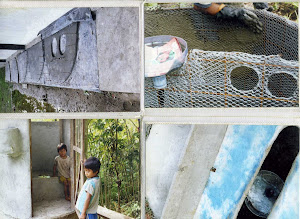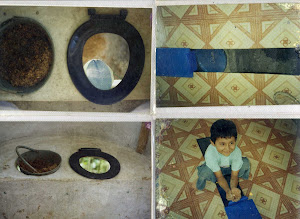(Scroll down for English.)
Necesitamos orinar mucho más de lo que hacemos popó (en especial cuando estamos en planteles educativos y lugares de trabajo), entonces es clave en el EcoSan armar Urinarios Sin Agua que sean eficaces, libres de olores y económicos. Ahora quisiera compartir con ustedes un modelo que recién inventé, que es de casi puro material reciclado, aparte de un embudo de 2 dólares.
(1) Calienta en el fuego un extremo de una manguera negra de polietileno de media pulgada e inserta el pico del embudo (de 18 cm de diámetro). Se conectan firmemente, sin necesidad de pegamento.
(2) Con una sierra, corta el otro extremo, en sesgo, a una longitud que alcance el fondo de la caneca.
(3) Con un cuchillo, corta un tapón para la caneca de una vieja sandalia tipo 'croc', en la parte gruesa cerca del talón, incluyendo unos centímetros de la parte que abraza el pie. Asegura que sea suficientemente grande para que entre apretado, al empujar un borde debajo del labio de la caneca.
(4) Con una navaja, corta un hueco en forma de rombo (de unos 1.5 cm), al lado de la parte que abraza el pie. Coloca la manguera en este hueco.
(5) Corta un cuadrado (de 4 cm) de la parte plana de una botella desechable de plástico tipo PET. Enróllalo para formar un tubo (7 mm de diámetro) e introdúzcalo en un hueco que se hace en el tapón con un gran clavo caliente.
(6) Haz un filtro del aire con tierra fértil, de dos botellas PET (de unos 400 ml), que la una entra justo en la otra. Llena las botellas cortadas y unidas de 7 cm de tierra, con un material fibroso (como cáscara de arroz) y mallas plásticas en ambos extremos.
(7) Corta un hueco redondo de 7 mm en la tapa de una botella, para poder colocarla encima del tubo de PET, y amarra el otro cuello de botella al filo del embudo.
¿Por qué no apesta?
(1) La manguera va hasta el fondo, por lo tanto los vapores de amoniaco que acumulan en la parte superior de la caneca no pueden salir por el embudo.
(2) Cuando la persona orina, el mismo volumen de aire con malos olores tiene que salir, pero se limpia durante su paso a través de la tierra.
Es fácil para los hombres usar, pero ¿qué pasa con las mujeres? También.
-- Algunas mujeres dicen que pueden orinar fácilmente en este urinario.
-- La mayoría de las mujeres preferirían hacer cuclillas completamente y se preocuparían de los microbios, entonces cada una puede tener su propia recipiente vacía de yogur o helado, orinar allí, verterlo en el urinario, enjuagarlo con agua, botar esa agua en el suelo de jardines o maceteros, colocar su tapa y guardarlo hasta la siguiente urgencia de devolver a la naturaleza.
La orina puede quedar en el urinario el tiempo que quiera, sin malos olores, y luego se le puede usar para fertilizar las plantas. Recuerda a diluirla con 3 o más veces más agua y regarla en el suelo (no en las hojas), en especial si las plantas están todavía delicadas y recién estabilizándose. Si no se ha sembrado el campo todavía, se le puede fertilizar con casi cualquier cantidad de orina y esperar al menos una semana antes de sembrarlo, para permitir a las bacterias asimilar el nitrógeno y así evitar el sobredosis de los cultivos.
Este urinario sencillo y sin agua debería ser aplicado en todas partes donde el agua es escasa, no se quieren sobrepoblaciones de algas en los ríos, las personas que viven aguas abajo no quieren tomar nuestros fármacos o queremos que nuestra agricultura sea más productiva (en otras palabras, en todas partes).
Avísame cómo te va en la construcción del tuyo ... o si desean ayuda.
Noticias de 2018: Ya hemos visto la manera de hacer el filtro de aire con una sola botella, haciendo huecos pequeños en el asiento con un clavo caliente ... y unas mañas para desdoblar las mallas plasticas, incluyendo un alambre o una piola en la mitad de las mallas más cerca de la boca de la botella para poder jalarlo. (Digo "las" porque es bueno poner 2 o más, para mayor fuerza.) Esto permite usar una mayor variedad de botellas (y evita la entrada de cucarachas a poner sus huevos). También, es mejor cortar el tapón de una espuma plástica gruesa (blanca en esta foto).
A New Model of Waterless Urinal
People need to pee a lot more than they need to poop (especially when they are in schools and work places), so it is key in EcoSan to work out Waterless Urinals that are effective, smell-free and economical. Now, I would like to share a model I just worked out that is almost entirely recycled, aside from the $2 funnel.
(1) Heat up in a fire the end of a section of half-inch, black, polyethylene hose and stick the tip of the funnel into it. They will attach firmly to each other, without the need for glue.
(2) With a saw, cut the other end of the hose, at an angle, such that it reaches to the bottom of the jug.
(3) With a knife, cut a plug for the jug from an old, worn-out croc sandal, from near the heel, including a few centimeters of the part that hugs the user's foot. Make sure that it is big enough to fit snugly, with one edge pushed under the lip of the jug.
(4) With a pocket knife, cut a diamond-shaped hole (roughly 1.5 cm on each side) next to the part that hugs the foot. Put the hose through this hole.
(5) Cut a square (4 cm on each side) from a flat section of a PET plastic beverage bottle. Roll it into a tube (7 mm diameter) and stick it through a hole in the plug that you can make with a large, hot nail.
(6) Make an air filter with fertile soil (as shown), from two 400 ml beverage bottles that happen to fit one into the other. Place 7 cm of soil into the joined bottles, with fibrous material (like rice hulls) and plastic mesh at each end.
(7) Cut a 7-mm hole in the bottle cap, so you can place it on the PET tube, and tie the other bottle neck to the edge of the funnel.
Why does it not stink?
(1) The hose goes all the way to the bottom, so the ammonia vapors that accumulate in the top of the jug cannot get out the funnel.
(2) When the user urinates, an equal volume of smelly air comes out, but it is cleaned as it passes through the soil.
Note that we do not use any random soil. Read more in the second part of this interview:
http://www.chekhovskalashnikov.com/water-sanitation/
This is easy for men to use, but what about women? They can, too.
-- Some women say that they could easily urinate in this urinal.
-- Most women would like to squat all the way down and would be worried about germs, so each could have her own empty yogurt or ice cream container to pee in, empty it into the urinal, rinse it with water, throw that water in the soil of gardens or flower pots, put the lid back on the container, and save it until the next urge to give back to Nature.
Urine can sit in this urinal as long as one likes, with no smell issues, and then be taken to fertilize your plants. Remember to dilute the urine with 3 or more times as much water, and to spread it on the soil (not the leaves), especially if the plants are delicate and are just getting established. If the field has not been planted yet, it can receive nearly all the urine you like to give it, and then wait a week before planting, to let the bacteria assimilate the nitrogen and avoid overdosing your crops.
This simple, Waterless Urinal should be used everywhere that water is scarce, algae blooms in the river are not desired, the people downstream do not want to randomly drink our pharmaceuticals, or we want our agriculture to be more productive (in other words everywhere).
















